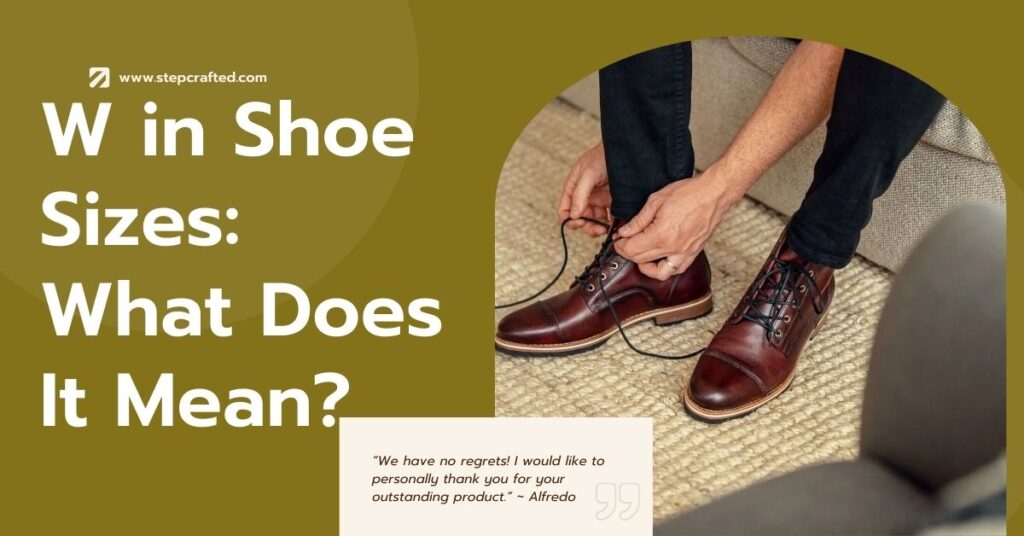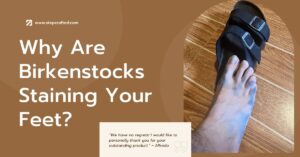Understanding Wide Shoe Sizes: What Are They?
When you’re shoe shopping and come across sizes with a W, you’re entering the Wide world of footwear sizing. This W doesn’t just mean something arbitrary; it’s a critical piece of terminology for those of us with broader feet.
Contents
ToggleI’ve always found the array of sizes—from Normal to Medium, and Extra Wide—a bit confusing. Then throw in the letters like M, D, E, or even numbers such as 2A, 2E, 4E, and it feels like you need a decoder just to buy a pair of shoes.
From personal experience, I’ve learned it’s essential to understand the different sizes including What does W mean in shoe size and how they fit to avoid discomfort. Wide sizes aren’t just about width; they’re about providing the right fit for your foot’s unique shape.
It took me a while and a lot of reading to get it right, but knowing whether you need a Medium, Wide, or even Extra Wide can make all the difference in how comfortable you feel throughout the day.
Shoe Width Sizes Explained
Just as clothing sizes can baffle the best of us, so too can shoe widths. When you see a W next to your shoe size, it’s diving into the world of width measurements—a concept that can be as confusing as trying to decipher a foreign language. This W signifies a wide fit, designed for those of us whose feet don’t conform to the standard width.
Navigating through different brands and styles, you’ll quickly notice that there’s no one-size-fits-all method to measuring shoe widths. Some use a letter system, while others opt for a word-based sizing system.
These sizes are often paired with letters placed next to the numerical size, forming a table of common conventions that can vary wildly from one company to another. This variability is why many of us find ourselves scratching our heads, trying to pick the best fit for our uniquely shaped feet.
For those of us who enjoy the world of dance, the importance of finding the right shoe width becomes even more pronounced. Dance shoes often come in multiple widths because, as we all know, feet come in a giant variety of shapes and sizes.
This recognition that not all feet are the same is a comfort, but it also adds an extra layer of complexity when trying to purchase the perfect pair.
Each shoe company picks which method they use to denote size and width, adding to the puzzle. However, understanding the different methodologies used by major brands can demystify the process. As someone who has navigated these waters more times than I can count, I hope to quickly sum up these methods and answer the most common questions shoe buyers ask regarding widths.
With a bit of knowledge and patience, hopefully, I can help you pick your best fit on your next shoe purchase, ensuring comfort and style go hand in hand.

Do Brands Offer Width Options for Shoes?
In the past 20-30 years, there’s been a notable shift in the shoe industry. While not all brands offer shoes in multiple widths, especially when comparing US brands to their European counterparts, the standard has been evolving.
European brands have traditionally stuck to a more uniform sizing system, lacking the width variations seen in the US. However, a change has been sweeping across both continents, with shoe manufacturers increasingly embracing multi-width sizing.
Today, some brands truly stand out for their commitment to inclusivity in shoe sizing. New Balance, Munro, and Clarks lead the way, offering a wide selection of widths across their full line of shoes. This evolution reflects a deeper understanding and appreciation of the diverse needs of consumers, ensuring everyone can find the perfect fit for their feet.
My personal journey in finding the right shoe has been greatly influenced by this change, as the wider options have allowed me to enjoy comfort and style without compromise.
Is Shoe Width Limited to Foot Width Only?
Many believe that width in shoe sizing merely affects the measurement from left to right across the foot, but it’s more nuanced. A wider shoe doesn’t just provide more space sideways; it also offers deeper depth in the toe box.
For instance, a size 10 B (a narrower standard width) shoe will not only be narrower from left to right but will also have less depth compared to a size 10 D (wider) shoe of the same model. This understanding is crucial for finding the perfect fit, as it affects more than just the width; it alters the overall shape and comfort of the shoe.
What Sets Men’s and Women’s Shoe Widths Apart?
In the world of shoe sizing, width is as critical as size. A notable difference between men’s and women’s widths lies in the standard sizing: a men’s medium width is marked as a ‘D’, while women’s medium is a ‘B’.
This distinction reflects that men typically have wider feet than women, making the standard width for a men’s shoe equivalent to a wide in a woman’s shoe. To grasp how widths vary across gender, reviewing charts can provide deeper insight, ensuring a fit that’s both comfortable and suitable to one’s feet, irrespective of gender.
Men’s Shoe Widths
| Standard Denotation | Spelled Out | Common Abbreviation |
|---|---|---|
| B | Narrow | N |
| D | Medium | M |
| 2E | Wide | W |
| 4E | Extra Wide | WW or XW |
Women’s Shoe Widths
| Standard Denotation | Spelled Out | Common Abbreviation |
|---|---|---|
| 4A | Super Slim (Extra Narrow) | SS |
| 2A | Narrow | N |
| B | Medium | M |
| D | Wide | W |
| 2E | Extra Wide | WW or XW |
What Exactly Are Wide Width Shoes?
Wide width shoes offer a variation of the standard shoe size, where the numerical length remains the same, but the width, particularly in the toe box and forefoot, is increased to accommodate those with wider feet.
Unlike normal sized shoes, these are designed not just for a wider fit but also for greater depth, addressing the needs of people whose feet are not only wider across the forefoot and toes but are taller as well.
This adjustment ensures that shoes can fit more comfortably around the heel and forefoot, providing similar support and stability without constraining or cramping feet that require more room.
Decoding Shoe Widths: By Letter
When we talk about shoe sizes, the letter W signifies a wider width than the standard or numerical size, designed to fit those with wider feet more comfortably.
However, the world of shoe widths doesn’t stop with just the letter W; it extends across a spectrum, labeled by letters that indicate everything from narrow to extra wide. Each letter has a specific meaning, greatly affecting the fit and comfort of the shoe.
A/2A/4A Width
Starting with the narrow end of the spectrum, an A width is labeled as Narrow or Extra Narrow, particularly for women, and Extra Narrow for men. With 2A, 3A, and 4A (expressed in letter form as AA, AAA, AAAA), the shoes become progressively narrower. In women’s shoes, these widths are sometimes referred to as Slim and Super Slim, synonymous with Narrow and Extra Narrow.
B Widths
Moving towards a more common size, a B width is the standard for women, deemed a Normal/Medium/Standard width. For men, this width is considered Narrow, underscoring the variability and significance of understanding these widths in selecting the right shoe.
D Widths
A D width represents the standard size for men, categorized as Normal/Medium/Standard, while for women, a D width is Wide. This variance between genders highlights the importance of widths in achieving the perfect fit.
E/2E/4E Widths
Lastly, the E widths, including 2E and 4E, mark the wider options available. For men, 2E is considered Wide, and 4E or larger is Extra Wide. In women’s shoes, 2E or larger also falls into the Extra Wide category. It’s worth noting that shoes available in sizes beyond 10E are often designed for specific needs, such as diabetic shoes, indicating how widths can increase to accommodate all foot shapes and conditions.
This exploration into shoe widths by letter not only illuminates the complexity behind shoe sizing but also emphasizes the necessity of accurate measurement and understanding when seeking the perfect fit. From Narrow to Extra Wide, knowing your width can transform your shoe-wearing experience, ensuring comfort and support tailored to your feet.
Shoe Widths by Size
When it comes to shoe sizes, the W signifies a wider width than the standard or numerical size, aimed to better fit those with wider feet. Yet, the classification of widths goes beyond just the W, delving into a nuanced system that uses letters to convey the width of a shoe. This system ensures everyone can find a shoe that fits comfortably, regardless of the shape or size of their feet.
Narrow/Extra Narrow Widths
For women, the letter A represents Narrow widths, with anything above 2A falling into the Extra Narrow category. Men have a slightly different scale, where a B width is Narrow, and an A width is considered Extra Narrow.
This distinction is subtle yet significant, as shoes marked Slim or Super Slim align with these Narrow and Extra Narrow measurements. The difference between A and 2A is minimal, leading manufacturers to typically offer 2A and 4A sizes to accommodate the subtle variations in foot width.
Medium Widths (Normal/Standard)
Medium, Normal, or Standard widths are denoted by a B for women and a D for men. If a shoe’s width doesn’t explicitly note its size, it’s generally safe to assume that it falls into this Medium category.
This standard size serves as the baseline from which all other widths are measured, offering a middle ground for those who don’t require narrow or wide shoes.
Wide/Extra Wide Widths
On the broader end of the spectrum, Wide and Extra Wide widths for women start with men’s Medium (D) being Wide for women, and anything E or bigger is considered Extra Wide. For men, Wide typically begins at E, with anything beyond 2E marked as Extra Wide.
Not all brands will offer widths in every increment, but 2E and 4E are among the most common options available, ensuring those with wider feet can find comfortable and supportive shoes.
Navigating the world of shoe widths can seem daunting, but understanding these categories makes it easier to find the perfect fit. Whether you need a Narrow, Medium, or Wide shoe, the key is to know your foot’s size and width to ensure comfort and avoid common foot problems.
Dance Shoe Widths: What’s Standard?
When delving into the world of shoe sizes, W stands out as a marker for a wider width, setting a standard that deviates from the numerical size norm.

This width is not just about the size; it’s about ensuring the fit is comfortable for those with wider feet. But, when it comes to Standard Dance Shoe Widths, the classification dives deeper with letters used to indicate the width of a shoe, each letter carrying its unique implication for the fit of the shoe.
- N signifies a narrow width, tailored for those who find that most shoes feel too spacious on the sides.
- M, representing a medium width, is where most feet will find their best fit, striking a balance between too tight and too loose.
- W, denoting a wide width, caters to individuals who often feel pinched or cramped in standard-width shoes.
Choosing between these widths comes down to what fits best for your feet. If you prefer a fit that’s snug or spacious, knowing these letters and what they represent becomes crucial. It’s about matching your feet to the shoe that will support and comfort them the best, whether that’s for daily wear or the specific demands of dance.
The option you want should be available in the shoe you choose, ensuring your feet are not just accommodated, but celebrated.
Dance Shoe Widths: Detailed Overview
In the context of shoe sizes, W symbolizes a wider width compared to the standard numerical size, aimed at providing a snug fit for individuals with broader feet. Here’s a breakdown of More Detailed Dance Shoe Widths, detailed through points:
- A represents the narrowest option, catering specifically to the slimmest of feet.
- B denotes a narrow width, slightly broader than A but still less than average.
- C is recognized as medium, the midpoint width suitable for most feet.
- D signals a wide fit, offering extra space for those requiring more room.
- E is labeled as the widest, designed for the broadest feet, ensuring comfort and stability.
Each of these letters serves as a standard to precisely indicate the shoe width, enabling dancers to select shoes that not only fit in length but also perfectly match the width of their feet.
Do You Need Wide Width Shoes? How to Tell
If you’ve ever frequently tried on shoes that seem to fit great length-wise but feel cramped on the sides, it’s a telltale sign that you need wide width shoes. Opting for a longer length as a common band-aid fix might grant a tad more width, but it’s a clumsy solution.
This extra space in the heel or toe box isn’t just bad for aesthetic reasons; it can cause chafing or blisters, alter your gait, and even lead to tripping. The best approach is finding a pair of shoes that fit correctly in both length and width.
Another reliable method for checking your foot width involves the Brannock Device, a tool commonly used by professionals to measure feet. Though most associate it with length, the Brannock Device also features a slider specifically designed to measure foot width.
This step ensures you’re not just guessing but making an informed decision based on professional measurements.
Understanding whether you require wide width shoes is key to not just comfort but also to maintaining a healthy, balanced walk. By paying attention to how your shoes fit and utilizing professional tools for measurement, you can ensure your footwear supports your feet in every way needed.
Do Feet Change in Width Over Time?
Many people who have traditionally worn a normal or medium width shoe might be surprised to find out they should actually be wearing wide width shoes. Often, what is blamed on a long break-in process is actually a case of the wrong size.
The Cleveland Clinic notes that it’s quite common for feet to grow wider as you age, a change attributed to factors like weight gain or normal changes in ligaments and tendons. If you’ve noticed your shoes feeling tighter than they used to be, it’s worth considering trying on a pair of wide width shoes.
This wider fit isn’t just about comfort; it’s about health. Poor-fitting shoes can lead to a myriad of foot issues, from blisters to more serious conditions that could alter your gait. Realizing that your feet may change over time, and acknowledging the need for a different size or width, is crucial.
A shoe that fits correctly can make a significant difference in your overall wellbeing and how you move through your day.
FAQ
Is it OK to wear wide shoes with normal feet?
Yes, it’s perfectly fine to wear wide shoes even if you don’t have wide feet. They provide extra room for your toes to move comfortably, reducing the risk of blisters and foot pain.
However, be careful that the shoes aren’t too wide, as this could lead to problems. Footwear should always be comfy but also snug and supportive to ensure the best balance between comfort and stability.
What does M 8.5 W 10 mean?
In shoe sizing, M/W typically refers to width, with M indicating a “medium” width—the standard width for most shoes. W signifies “wide” width, designed for people with wider feet.
Therefore, when you see M 8.5 W 10, it’s identifying two different aspects: the M 8.5 denotes a Men’s shoe in a size 8.5 with medium width, and W 10 points to a Women’s shoe in a size 10 with wide width, ensuring a fit that accommodates the unique width and size needs of the wearer.
What does M5 W7 mean?
When you see (M5) (W7) in shoe sizes, it’s specifying gender and size: (M5) translates to a Men’s US 5, and (W7) indicates a Women’s US 7. This differentiation is key for finding the correct fit, as Men’s and Women’s sizes are based on different standard numerical systems, ensuring a wider or more precise width and size match for each individual.
How do I know if I need a wide shoe size?
Signs you May Need a Wide Width include Blisters forming on the outside of your big toe and pinky toe, experiencing Numbness or tingling sensations in your feet, or if your foot spills over the side of your shoe.
Those with existing foot conditions such as bunions, hammertoes, or Morton’s neuroma should also consider a wider fit to ensure comfort and avoid further discomfort.
Is 8.5 the same as 8 wide?
No, 8.5 and 8 wide (8W) are not the same. The number 8.5 represents a shoe size of 8 1/2, indicating the length of the shoe, and is typically considered a regular or medium (M) width. On the other hand, 8W denotes a size 8 shoe with a wider width, specifically designed for feet that need more space across. Similarly, an 8N would imply a size 8 with a narrow width.
It’s crucial to select the correct width for comfort and proper fit, beyond just the numerical shoe size.
Read More!
- What does ew mean in shoe size?
- What does m mean in shoe size?
- What does c mean in shoe size?
- What does h mean in shoe size?
- What nike shoes make you taller?





